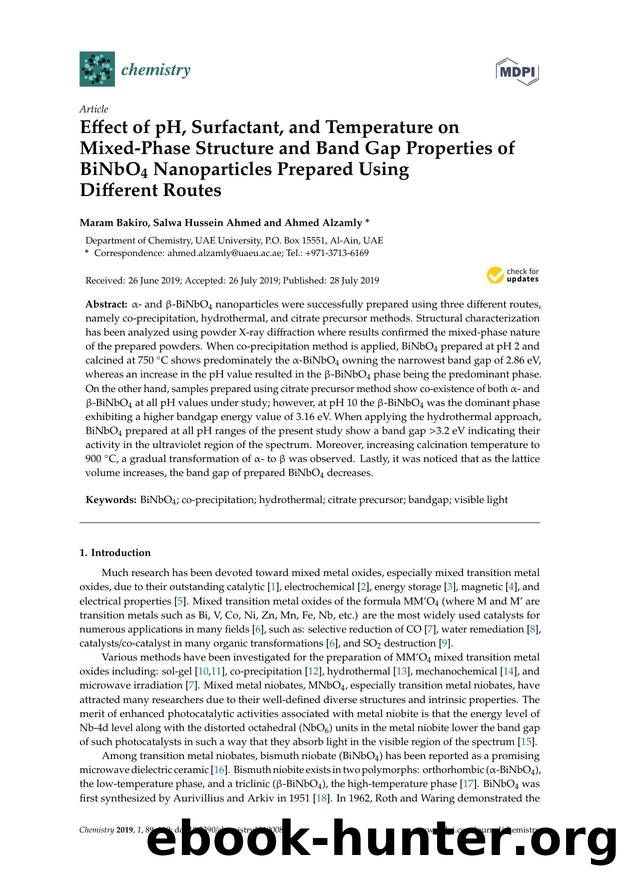Effect of pH, Surfactant, and Temperature on Mixed-Phase Structure and Band Gap Properties of BiNbO4 Nanoparticles Prepared Using Different Routes by Maram Bakiro Salwa Hussein Ahmed & Ahmed Alzamly

Author:Maram Bakiro, Salwa Hussein Ahmed & Ahmed Alzamly
Format: pdf
Tags: - and -BiNbO4 nanoparticles were successfully prepared using three different routes, namely co-precipitation, hydrothermal, and citrate precursor methods. Structural characterization has been analyzed using powder X-ray diffraction where results confirmed the mixed-phase nature of the prepared powders. When co-precipitation method is applied, BiNbO4 prepared at pH 2 and calcined at 750 C shows predominately the -BiNbO4 owning the narrowest band gap of 2.86 eV, whereas an increase in the pH value resulted in the -BiNbO4 phase being the predominant phase. On the other hand, samples prepared using citrate precursor method show co-existence of both - and -BiNbO4 at all pH values under study; however, at pH 10 the -BiNbO4 was the dominant phase exhibiting a higher bandgap energy value of 3.16 eV. When applying the hydrothermal approach, BiNbO4 prepared at all pH ranges of the present study show a band gap >3.2 eV indicating their activity in the ultraviolet region of the spectrum. Moreover, increasing calcination temperature to 900 C, a gradual transformation of - to was observed. Lastly, it was noticed that as the lattice volume increases, the band gap of prepared BiNbO4 decreases., BiNbO4; co-precipitation; hydrothermal; citrate precursor; bandgap; visible light
Download
This site does not store any files on its server. We only index and link to content provided by other sites. Please contact the content providers to delete copyright contents if any and email us, we'll remove relevant links or contents immediately.
Alchemy and Alchemists by C. J. S. Thompson(3451)
The Elements by Theodore Gray(2998)
The Club by A.L. Brooks(2862)
How to Make Your Own Soap by Sally Hornsey(2829)
Drugs Unlimited by Mike Power(2545)
Wheels of Life by Anodea Judith(2098)
Cracking the LSAT, 2012 Edition by Princeton Review(1883)
Cracking the Sat French Subject Test, 2013-2014 Edition by The Princeton Review(1829)
Perfume by Jean-Claude Ellena(1782)
The Flavor Matrix by James Briscione(1775)
The Cosmic Machine: The Science That Runs Our Universe and the Story Behind It by Scott Bembenek(1726)
Quantitative and Pattern Recognition Analyses of Five Marker Compounds in Raphani Semen using High-Performance Liquid Chromatography by Unknown(1701)
MCAT Physics and Math Review by Princeton Review(1637)
1000 Multiple-Choice Questions in Organic Chemistry by Organic Chemistry Academy(1621)
The Thing Around Your Neck by Chimamanda Ngozi Adichie(1600)
Handbook of Modern Sensors by Jacob Fraden(1544)
Cracking the SAT Premium Edition with 6 Practice Tests, 2017 by Princeton Review(1539)
Synchrotron Light Sources and Free-Electron Lasers by Eberhard J. Jaeschke Shaukat Khan Jochen R. Schneider & Jerome B. Hastings(1524)
A is for Arsenic: The Poisons of Agatha Christie (Bloomsbury Sigma) by Kathryn Harkup(1507)
